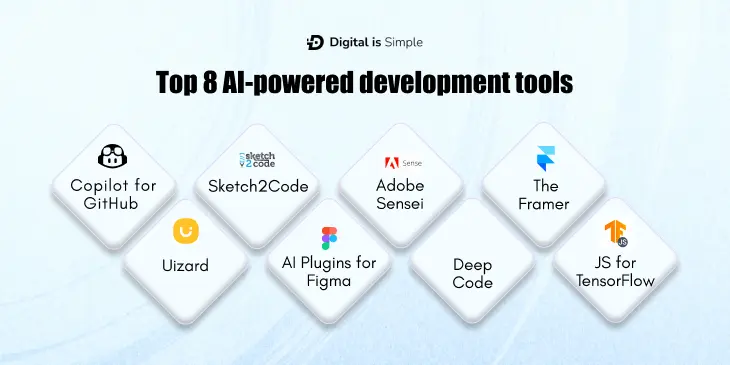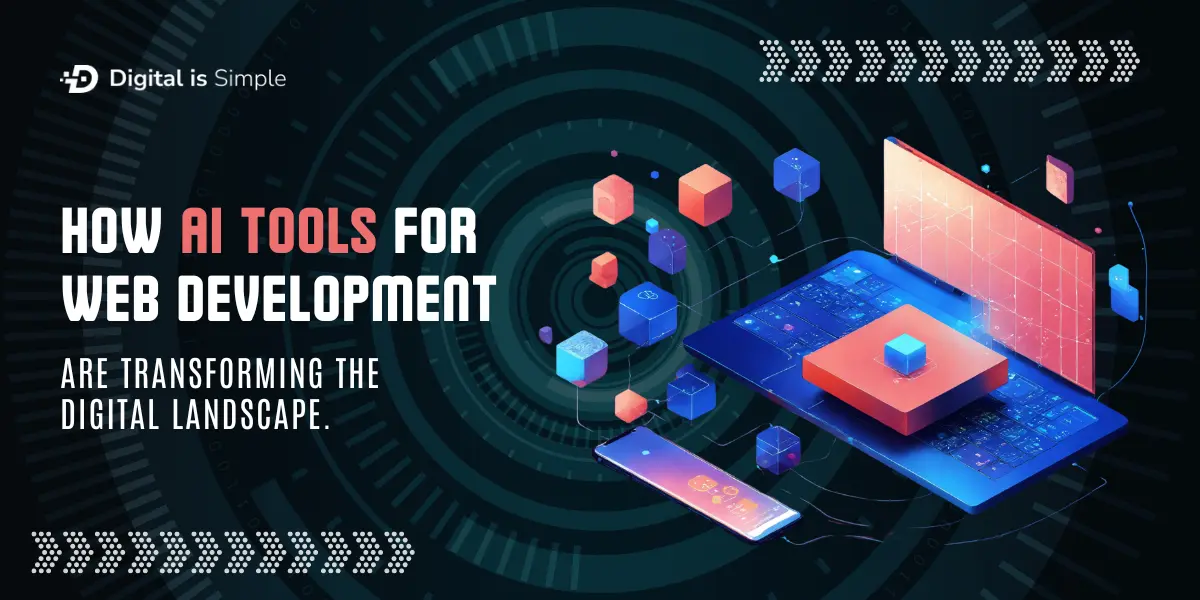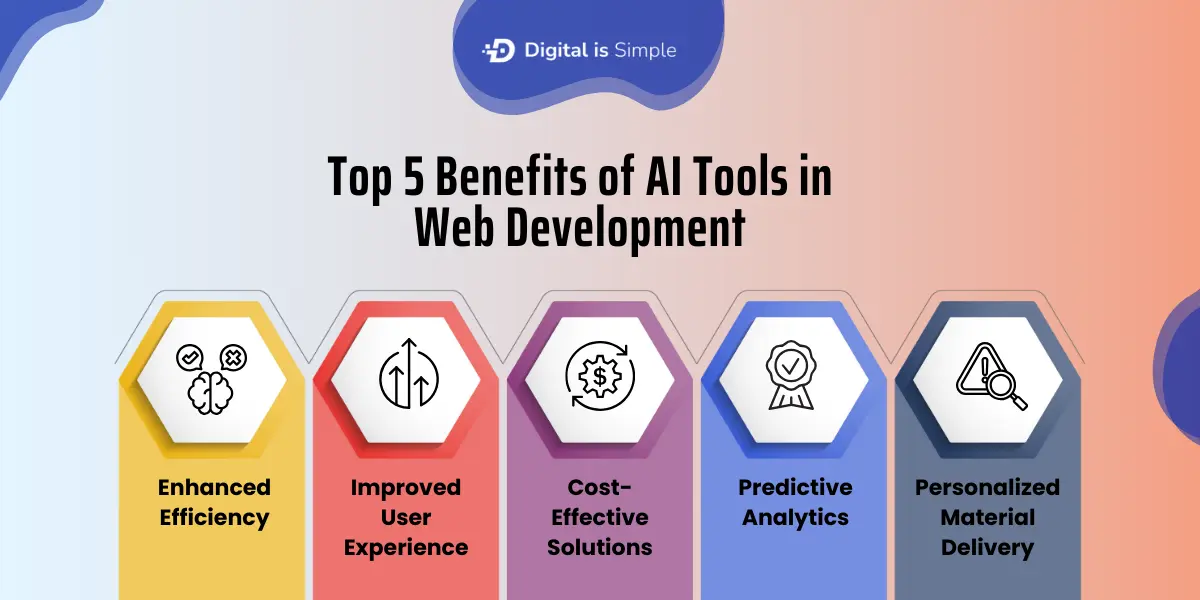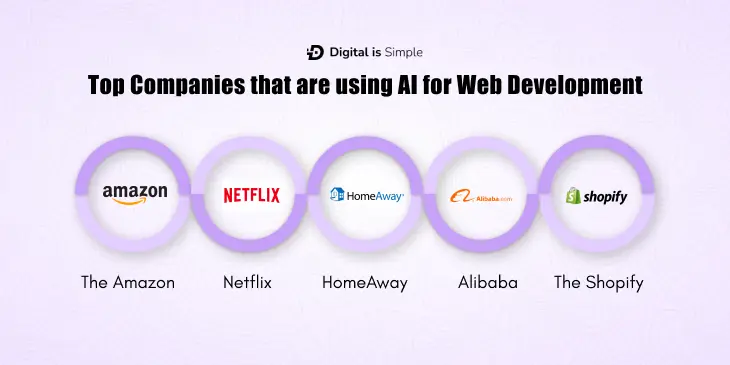Assume you are introducing a new product on the internet. Moreover, the website must be perfect—it must load quickly, be easy to use, and be built to turn visitors into devoted followers. However, maintaining a website might seem like an impossible undertaking given the continuous need for upgrades, optimized layouts, and customized experiences. Furthermore, entrepreneurs often have to manage development teams, design modifications, and the increasing need for real-time data. In this blog, we can see the AI tools for web development and its features and uses.
Imagine a program that could automate all of that, working in the background to make sure your website is not just operating efficiently. Furthermore, but also adjusts in real time to the demands of users and industry trends. Moreover, presenting AI tools for web development – a revolutionary solution for contemporary enterprises. Furthermore, the trend is evident, with 60% of enterprises using AI in their web development strategy by 2024.
AI tools for web development are personalizing digital experiences to guarantee organizations can expand effectively. Furthermore, optimizes user experiences, and remains ahead of the curve, just as marketers customize campaigns to match client demands. Moreover, nowadays, having a website is no longer enough; you also need to have an intelligent, adaptable, and dynamic online presence. Furthermore, AI is driving the web development industry of the future.
Top 5 Benefits of AI Tools in Web Development: Boost Efficiency by 40%
-
Enhanced Efficiency:
Furthermore, AI solutions automate monotonous work, freeing up professionals to concentrate on more intricate aspects of site design and development. Moreover, development time is cut by 35% as a result.
-
Improved User Experience:
Furthermore, by using AI, websites can adjust dynamically to the tastes and actions of their visitors, resulting in a 25% increase in user engagement.
-
Cost-Effective Solutions:
Furthermore, businesses can reduce development expenses by 20% by automating some processes, with AI-driven optimization contributing to this decrease in overhead.
-
Predictive Analytics:
Furthermore, AI-powered analytics provide forecasts about user behavior, enabling businesses to make data-driven choices that increase conversion rates by thirty percent.
5. Personalized Material Delivery:
Furthermore, by providing consumers with suggestions and tailored material, AI systems can increase customer satisfaction by 40%.
Top Features of Essential AI Tools for Web Development
-
Automated Code Generation:
Furthermore, GitHub Copilot and other AI-powered technologies help developers by producing code suggestions and enhancing correctness while lowering human error.
-
Real-Time User Behavior Analysis:
Moreover, AI technologies monitor user behavior in real-time and provide consumer preference insights that can be used to optimize the website right away.
-
Chatbot Integration:
Furthermore, a lot of AI solutions make it possible to easily include chatbots in websites, which improves user retention by 15% and improves customer care.
-
SEO Optimization:
Moreover, by evaluating keywords, meta tags, and user interaction, AI systems automatically optimize websites for search engines, increasing their exposure in search results by 50%.
-
Design assistance:
Furthermore, companies can save time on UI/UX design by using tools like Uizard, which employs AI to automatically produce design prototypes based on user input.
Top 8 AI-powered development tools that are revolutionizing the industry
Here, we examine the top 8 AI-powered development tools that are revolutionizing the industry and the salient characteristics that set them apart from the competition. These technologies can streamline your operations, lower mistake rates, and improve your online visibility whether you are a startup or an established business.

1. Copilot for GitHub
Moreover, a machine learning model is used by GitHub Copilot, an AI-powered code generation tool, to propose whole functions, individual lines of code, and even contextual adjustments. Furthermore, easily included in your code editor, it changes as you work, making it a vital tool for developers looking to optimize their coding assignments.
- Context-Aware Suggestions: Furthermore, it recognizes the context of the project and provides customized code recommendations instantly.
- Faster Code Completion: Moreover, it works by automatically finishing lines and functions based on your coding habits, saving you hours of work.
- Natural Language Processing: Furthermore, Copilot converts developer requirements from simple English descriptions into functional code.
- Multi-Language Support: Furthermore, compatible with Python, JavaScript, and TypeScript, among other programming languages.
- Error Prediction: Moreover, identify possible problems in your code and make recommendations for solutions before you encounter execution failures.
2. Uizard
Using AI, Uizard is a design tool that turns simple ideas into complete UI/UX designs. Furthermore, it is perfect for companies that don’t need a lot of design expertise and want to quickly prototype and visualize user interfaces
Highest Five Attributes:
- Rapid Prototyping: Furthermore, creates finished designs from drawings or preliminary concepts in a matter of minutes.
- AI-Powered Recommendations: Furthermore, offers design recommendations in line with contemporary UI/UX guidelines.
- Collaboration-Friendly: Moreover, teams can work together more easily since several users can work on the same design.
- Design to Code: Furthermore, bridges the gap between designers and developers by automatically creating code snippets from the design.
- Real-Time Updates: Furthermore, instantaneously updates all design iterations, ensuring stakeholders are in sync.
3. Sketch2Code
Moreover, Microsoft created Sketch2Code, a tool that takes hand-drawn designs and turns them into working HTML prototypes. Furthermore, it is now simpler for developers and designers to close the gap between design and execution thanks to this AI-driven solution.
Highest Five Attributes:
1. Sketch Recognition: Furthermore, AI converts hand-drawn drawings into HTML components by interpreting them.
2. Rapid Prototyping: Moreover, quickly turns design drawings into HTML code, speeding up the development process.
3. Error Reduction: Furthermore, lowers the amount of human design interpretation to ensure greater accuracy.
4. Collaboration Tool: Moreover, by providing a common vision, this tool helps design and development teams collaborate more easily.
5. Real-Time Adjustments: Furthermore, the HTML prototype refreshes immediately as designers make changes to drawings.
4. AI Plugins for Figma
Moreover, the popular collaborative design tool Figma gains substantial strength from its combination with AI plugins. Furthermore, these improvements to AI speed up site design, streamline operations, and provide better design outcomes.
1. AI Design Suggestions: Furthermore, provides layout and design enhancements based on AI-driven insights.
2. Efficient Prototyping: Moreover, by automating repetitive operations, prototype construction takes less time.
3. Team Collaboration: Furthermore, Quicker design iterations are possible since several stakeholders can engage with the design in real time.
4. Data-Driven Designs: Moreover, makes use of AI analytics to comprehend user preferences and adjust the design in line with them.
5. Version Control: Furthermore, maintain track of all design revisions and iterations to provide smooth version control.
5. Adobe Sensei
Furthermore, Adobe’s artificial intelligence and machine learning architecture, known as Adobe Sensei, improves user analytics, web design, and marketing automation. Moreover, AI tools for web development businesses can use them to better engage customers by customizing information and designing experiences.
1. Material Personalization: Furthermore, based on user behavior and choices, the material is automatically personalized for each user.
2. AI-Powered Insights: Moreover, conversational AI solutions provide useful information derived from user interactions to enhance the design of websites.
3. Faster Asset Management: Furthermore, automates digital asset labeling, classification, and search.
4. Intelligent Design Support: Furthermore, it makes suggestions for design modifications to enhance user interaction and engagement.
5. Automated Workflows: Moreover, accelerates the design process by streamlining repetitive operations like resizing pictures and layouts.
6. DeepCode
Real-time code review and vulnerability detection are provided by DeepCode, an AI-powered solution. Furthermore, AI models provide recommendations that go beyond syntax to assist developers in writing safer and more effective code.
1. Real-Time Code Scanning: Furthermore, checks code automatically as you type, looking for errors and vulnerabilities.
2. Code Optimisation: Moreover, offers suggestions for enhancing your code’s security and efficiency.
3. Language Support: Furthermore, AI tools for web development are compatible with Python, Java, and JavaScript, among other programming languages.
4. Team Collaboration: Furthermore, promotes collective code quality by enabling team members to see and apply recommended modifications.
5. Continuous Learning: Moreover, over time, it improves recommendations based on interactions with developers.
7. The Framer
Framer is a design tool that focuses on using AI to create interactive prototypes. Furthermore, teams trying to improve their user interfaces love it because it keeps designers iterating on ideas quickly and gives them feedback in real time.
1. Interactive Prototyping: Moreover, enables designers to produce completely interactive prototypes devoid of programming.
2. Real-Time Feedback: Furthermore, AI tools for web development provide instantaneous, AI-powered feedback on interface components and design features.
3. AI Design Adjustments: Furthermore, adapts design components automatically by using data on user interaction.
4. Collaborative Workspace: Moreover, several team members have real-time access to update and examine the design.
5. Cross-Platform Interoperability: Furthermore, it is easy to export and test designs on many platforms.
8. Js for TensorFlow
Google has developed a sophisticated tool called TensorFlow.js that lets developers create and implement machine learning models right in the browser. Furthermore, it is the foundation for developing predictive and dynamic user experiences, which makes it perfect for companies wishing to apply AI in real-time apps.
1. In-Browser Machine Learning: Furthermore, it gives web apps access to real-time AI capabilities.
2. Quick Integration: Moreover, quick integration with current web projects means less time spent on deployment.
3. Data Processing: Furthermore, it enables real-time processing of user data to provide personalized experiences.
4. Cross-Platform Flexibility: Moreover, it ensures smooth operation on any device by working across many platforms.
5. Pre-Trained Models: Furthermore, it provides a pre-trained model library, which facilitates the addition of machine learning features.
Related Blog – AI Powered Chatbots
The Top 5 AI Web Development Trends for 2024
1. Generative AI for Code Writing:
Furthermore, copilot and other AI tools are being utilized more often to create whole code portions, eliminating the need for human coding.
2. AI-Driven Personalisation:
Moreover, by modifying information and suggestions in real time based on data, websites are using AI to provide individualized user experiences.
3. Voice Search Optimisation:
Furthermore, with AI tools for web development and the popularity of AI assistants and smart speakers, companies now place a high premium on making their websites voice search-friendly.
4. AI for Accessibility:
Furthermore, AI is being used to automatically modify website designs for people with impairments, such as producing material that is readable by screen readers.
5. AI-Enhanced Cybersecurity:
Moreover, to counteract the increasing number of cyberattacks, websites are using AI capabilities to automatically monitor and fight against harmful assaults.
Top Companies that are using AI for Web Development
1. The Amazon
Amazon customizes each user’s purchasing experience in real time by using artificial intelligence.
1. One of the features is Dynamic Content Adaptation, which modifies product displays according to user activity.
2. Predictive Analytics: Furthermore, projects purchases in the future to improve relevance.
3. Personalised Suggestions: Moreover, it offers tailored product recommendations.
4. Enhanced Search: Furthermore, by AI tools for web development comprehending user intent, search results are refined.
5. Real-Time Inventory: Moreover, dynamically updates the availability of products.
2. Netflix
AI is used by Netflix to provide content recommendations and increase viewer engagement.
1. Content Recommendations: Moreover, it makes recommendations for TV series and films based on past viewings.
2. Dynamic Thumbnails: Furthermore, customize thumbnails to boost click-through rates.
3. Behavior Analysis: Moreover, it modifies suggestions in response to user interactions.
4. Content Optimisation: Furthermore, it uses AI insights to direct the creation of content.
5. User Retention: Furthermore, it offers ideas for relevant material to keep users interested.
3. HomeAway
Airbnb’s AI-powered search and recommendation system improves user experience.
1. Smart Search: Furthermore, it uses AI to enhance search results.
2. Customised Suggestions: Moreover, they adapt listings to individual user preferences.
3. Dynamic Pricing: Furthermore, it modifies prices in response to current information.
4. AI Chatbots: Furthermore, it offers immediate assistance and trip recommendations.
5. Fraud Detection: Moreover, this process finds and stops fraudulent activity.
4. Alibaba
Furthermore, Alibaba uses AI to streamline operations and provide a customized purchasing experience.
1. Personalised Shopping: Moreover, customizes product recommendations for individual customers.
2. Optimisation of the Supply Chain: Furthermore, improves inventory control and transportation.
3. Chatbots powered by AI: Moreover, automates customer service.
4. Furthermore, predictive Analytics modifies tactics based on demand forecasts.
5. Visual Search: Furthermore, enables image-based product searches.
5. The Shopify
Furthermore, Shopify helps companies optimize their e-commerce systems by using AI.
Furthermore, the use of AI chatbots, which automate customer support.
1. Data-Driven Layouts: Moreover, suggest modifications to designs in response to user activity.
2. Personalised Marketing: Furthermore, AI tools for web development develop campaigns with a specific audience in mind.
3. Inventory Management: AI AI-powered chatbots control stock levels and project demand.
4. Sales Optimisation: Offers information to increase conversion rates.
Related Blog – Generative AI Challenges
Top Four AI Website Development Success Stories
1. Personalised Playlists on Spotify
Furthermore, due to an excessive volume of material and a wide range of listener tastes, Spotify has trouble attracting and maintaining members.
Furthermore, the business put in place an AI-powered recommendation engine that builds customized playlists according to listener preferences, moods, and listening histories.
With a remarkable 25% increase in daily active users and a substantial bump in subscription renewals, this method resulted in a considerable improvement in user engagement. Furthermore, additionally, the approach improved Spotify’s comprehension of listener behavior, which raised user satisfaction levels.
2. The Visual Search Functionality of eBay
eBay had problems with their product search user experience, which resulted in customer unhappiness and lost sales chances.
Furthermore, an AI-powered visual search engine has been incorporated by eBay, enabling users to input photographs and locate comparable goods with speed and accuracy.
Moreover, the visual search tool enhanced the entire shopping experience by reducing search times by 20%, increasing user happiness, and resulting in a 15% boost in sales conversions.
3. Inventory Management System of H&M
Furthermore, inventory management inefficiencies at H&M resulted in stock imbalances and operating difficulties.
By using AI algorithms, the business was able to precisely estimate demand and evaluate sales data, optimizing inventory levels and lowering stockouts.
Furthermore, by reducing surplus inventory by 30% and improving product availability by 25%, this AI integration improved customer happiness and streamlined operations.
4. Zalando’s Automation of Customer Service
Moreover, Zalando saw a surge in customer care inquiries, which put a burden on its resources and caused response times to increase.
Furthermore, Zalando has an AI chatbot in place that answers standard questions and offers prompt assistance, freeing up human agents to address more complicated problems.
Furthermore, the AI chatbot improved customer service productivity and user experience by handling 60% of client inquiries independently and cutting down on average response times by 40%.
How to Select AI Tools for Website Creation
Moreover, businesses should prioritize scalability, simplicity of integration, and the tool’s real-time insight delivery when choosing the best AI solution for web development requirements.
Furthermore, employing professionals from a PHP web development company or an Android app development company can help expedite the procedure, guaranteeing seamless customization and deployment.
Additionally, keeping up with AI advancements will help you maintain a competitive online presence and future-proof your web development plans.
Wrapping Things Up
The usage of AI technologies has revolutionized web development via work automation, more personalization, and an improved user experience. Businesses will be able to provide their clients with more creative and effective services as long as they continue to use this technology. Selecting the appropriate AI development company technologies is crucial for businesses that want to remain ahead of the curve to change their digital operations and secure long-term success in 2024 and beyond.
FAQ
1. How can AI technologies increase the effectiveness of website development?
Up to 30% less time is spent on development when coding, design, and testing processes are automated by AI techniques.
2. Can AI technologies improve the way people interact with websites?
Yes, personalized user interactions with AI technologies increase engagement and increase retention rates by 25%.
3. What financial benefits can companies anticipate from using AI in web development?
Businesses can save up to 40% on development costs by automating processes using AI solutions, which also reduce operating costs.


